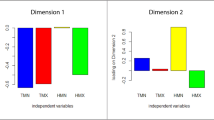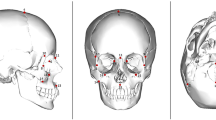Abstract
The geographical and climatic patterning in craniofacial morphology among recent hominids has been regarded as relatively reliable evidence of environmental adaptation and natural selection, which is largely attributed to thermoregulation. However, the relative influence of genetic and environmental factors on craniofacial features is unclear. Our study employed 3D laser scanning techniques to evaluate the association between geographical (latitude), climatic (annual temperature) factors, and 3D craniofacial measurements in 18 recent populations through bivariate correlation analysis. Significant correlations were found among braincase surface area, zygomatic bone surface area, cranial-facial index (facial surface area relative to braincase surface area) and local temperature, and a clear latitudinal gradient was also found in variation of braincase surface area. No significant correlations were found between zygomatic bone surface area, cranial-facial index and latitude. Our analysis supports the idea that the braincase functions as a radiator and is closely related to direct sunlight. We also suggest that absolute/relative craniofacial surface area varies consistently with predictions derived from Bergmann’s Rule. The mosaic craniofacial traits of American Indians may reflect retention of cold-derived, ancestral features, as well as a response to a slightly warmer climate. Because different craniofacial regions preserve environmental/genetic signatures differentially, caution is suggested when craniofacial anatomy is used for phylogenetic reconstruction and functional-morphological analysis.
Similar content being viewed by others
References
Auerbach B M. 2007. Human skeletal variation in the new world during the Holocene: Effects of climate and subsistence across geography and time. Doctoral Dissertation. Johns Hopkins University
Beals K L. 1983. Climate and the evolution of brachycephalization. Am J Phys Anthropol, 62: 425–437
Beals K L, Smith C L, Dodd S M. 1972. Head form and climatic stress. Am J Phys Anthropol, 37: 85–92
Beals K L, Smith C L, Dodd S M, et al. 1984. Brain size, cranial morphology, climate, and time machines (and comments and reply). Curr Anthropol, 25: 301–220
Berry A C, Berry R J. 1967. Epigenetic variation in the human cranium. J Anat, 101: 367–379
Carlson D S. 1976. Temporal variation in prehistoric Nubian crania. Am J Phys Anthropol, 45: 467–484
Chen S. 2009. A research on the human skeletons of Sanyan culture from Lamadong graveyard (in Chinese with English abstract). Doctoral Dissertation. Jilin University
Cheverud J M, Buikstra J E. 1981. Quantitative genetics of skeletal nonmetric traits in the Rhesus macaques on Cayo Santiago. I. Single trait heritabilities. Am J Phys Anthropol, 54: 43–49
Coon C S. 1962. The Origin of Races. New York: Knopf
Coon C S. 1955. Some problems of human variability and natural selection in climate and culture. Am Nat, 89: 257–279
Cramon-Taubadel N. 2011. Global human mandibular variation reflects differences in agricultural and hunter-gatherer subsistence strategies. Proc Natl Acad Sci USA, 108: 19546–19551
Crognier E. 1981. Climate and anthropometric variations in Europe and the Mediterranean area. Ann Hum Biol, 8: 99–107
Dean M C. 1988. Another look at the nose and the functional significance of the face and nasal mucous membrane for cooling the brain in fossil hominids. J Hum Evol 17: 715–718
Dodo Y, Sawada J. 2010. Supraorbital foramen and hypoglossal canal bridging revisited: Their worldwide frequency distribution. Anthropol Sci, 118: 65–71
Doran G H, Dickel D N, Ballinger W E, et al. 1986. Anatomical, cellular and molecular analysis of 8,000-yr-old human brain tissue from the Windover archaeological site. Nature, 323: 803–806
Falk D. 1990. Brain evolution in Homo: The “radiator” theory. Behav Brain Sci, 13: 333–344
Falk D. 2007. Constraints on brain size: The radiator hypothesis. In: Preuss T M, Kaas J H, eds. Oxford: Academic Press. 347–354
Freckleton R P, Harvey P H, Pagel M. 2003. Bergmann’s rule and body size in mammals. Am Nat, 161: 821–825
Friess M, Marcus L F, Reddy D P, et al. 2002. The use of 3D laser scanning techniques for the morphometric analysis of human facial shape variation. BAR Int Ser, 1049: 31–35
Hanihara T. 2000. Frontal and facial flatness of major human populations. Am J Phys Anthropol, 111: 105–134
Harvati K, Weaver T D. 2006. Human cranial anatomy and the differential preservation of population history and climate signatures. Anat Rec A Discov Mol Cell Evol Biol, 288: 1225–1233
He J N. 2001. The human remains at Yinniugou tombs, Liangcheng city, Inner Mongolia (in Chinese with English abstract). Archaeology, 11: 80–86
Henneberg M, Steyn M. 1993. Trends in cranial capacity and cranial index in Subsaharan Africa during the Holocene. Am J Hum Biol, 5: 473–479
Hernández M, Fox C L, García-Moro C. 1997. Fueguian cranial morphology: The adaptation to a cold, harsh environment. Am J Phys Anthropol, 103: 103–117
Hotz F C. 1879. Notes on intra-ocular lesions produced by sunstroke. Am J Med Sci, 78: 105–113
Hrdlička A. 1910. Contribution to the anthropology of Central and Smith Sound Eskimos. Anthrop Papers Am Mus Nat Hist, V: 177–280
Ji L, Xu J, Zhang Y. 2012. Environmental adaptation studies in human populations. Chin Sci Bull, 57: 112–119
Lahr M M. 1995. Patterns of modern human diversification: Implications for Amerindian origins. Am J Phys Anthropol 38: 163–198
Larsen C S. 1995. Biological changes in human populations with agriculture. Ann Rev Anthropol, 24: 285–213
Li F J. 2004. A research of the Neolithic human skeletons from Jiangjialiang, Yangyuan in Hebei province, China (in Chinese with English abstract). Doctoral Dissertation. Jilin University
Malhi R, Smith D. 2002. Brief communication: Haplogroup X confirmed in prehistoric North America. Am J Phys Anthropol, 119: 84–86
Marcott S A, Shakun J D, Clark P U, et al. 2013. A reconstruction of regional and global temperature for the past 11,300 years. Science, 339: 1198–1201
Rae T C, Viðarsdóttir U S, Jeffery N, et al. 2006. Developmental response to cold stress in cranial morphology of Rattus: Implications for the interpretation of climatic adaptation in fossil hominins. Proc R Soc B, 273: 2605–2610
Roseman C C. 2004. Detecting interregionally diversifying natural selection on modern human cranial form by using matched molecular and morphometric data. Proc Natl Acad Sci USA, 101: 12824–12829
Ruff C B. 1991. Climate and body shape in hominid evolution J Hum Evol, 21: 81–105
Ruff C B. 1993. Climatic adaptation and hominid evolution: The thermoregulatory imperative. Evolutionary Anthropology: Issues, News, and Reviews, 2: 53–60
Ruff C B. 2002. Variation in human body size and shape. Annu Rev Anthrop, 31: 211–232
Shea B T. 1977. Eskimo craniofacial morphology, cold stress and the maxillary sinus. Am J Phys Anthropol 47: 289–300
Sholts S B, Flores L M, Walker P L, et al. 2011. Comparison of coordinate measurement precision of different landmark types on human crania using a 3D laser scanner and a 3D digitiser: Implications for applications of digital morphometrics. Int J Osteoarchaeol, 21: 535–543
Sholts S B, Wärmländer S K T S, Flores L M, et al. 2010. Variation in the measurement of cranial volume and surface area using 3D laser scanning technology. J Forensic Sci, 55: 871–875
Smith H F. 2009. Which cranial regions reflect molecular distances reliably in humans? Evidence from three-dimensional morphology. Am J Hum Biol, 21: 36–47
Smith H F, Terhune C E, Lockwood C A. 2007. Genetic, geographic, and environmental correlates of human temporal bone variation. Am J Phys Anthropol, 134: 312–322
Temple D H, Matsumura H. 2011. Do body proportions among Jomon foragers from Hokkaido conform to ecogeographic expectations? Evolutionary implications of body size and shape among northerly hunter-gatherers. Int J Osteoarchaeol, 21: 268–282
Thomson A. 1903. A consideration of some of the more important factors concerned in the production of man’s cranial form. J Anthropol Inst Great Brit Ireland, 33: 135–166
Torgerson J. 1950. A roentgenologic study of the metopic suture. Acta Radial, 33: 1–11
Weaver T D, Roseman C C, Stringer C B. 2007. Were Neandertal and modern human cranial differences produced by natural selection or genetic drift? J Hum Evol, 53: 135–145
Weiner J S. 1954. Nose shape and climate. Am J Phys Anthropol, 12: 615–618
Weisenburg T H. 1912. Nervous symptoms following sunstroke. J Am Med Assoc, 58: 2015–2017
Wu R K, Wu X Z, Zhang Z B. 1984. Anthropometric Methods (in Chinese). Beijing: Science Press. 11–25
Wu X J, Liu W, Zhang Q C, et al. 2007. Craniofacial morphological microevolution of Holocene populations in northern China. Chin Sci Bull, 52: 1661–1668
Zhang J L. 2008. The research on the human skeletons of Han and Jin Dynasties from Taojiazhai graveyard in Xining city of Qinghai Province (in Chinese with English abstract). Doctoral Dissertation. Changchan: Jilin University
Zhang L, Fang X, Ren G, et al. 1997. Environmental changes in the north China farming-grazing transitional zone (in Chinese with English abstract). Earth Sci Front, 4: 127–136
Zhu H. 2004. Physical Anthropology (in Chinese). Beijing: Higher Education Press. 329–355
Zhu H, Wei D. 2006. The research on the human remains from Shuiquan graveyard in Aohan Banner, Inner Mongolia (In Chinese). In: Zhu H, ed. Changchun: Jilin People’s Publishing House. 15–34
Zhu K Z. 1973. A preliminary study on the climatic changes in the past 5000 years in China (in Chinese). Sci China, 2: 168–139
Author information
Authors and Affiliations
Corresponding authors
Rights and permissions
About this article
Cite this article
Pan, L., Wei, D. & Wu, X. Latitudinal and climatic distributions of 3D craniofacial features among Holocene populations. Sci. China Earth Sci. 57, 1692–1700 (2014). https://doi.org/10.1007/s11430-014-4850-3
Received:
Accepted:
Published:
Issue Date:
DOI: https://doi.org/10.1007/s11430-014-4850-3




